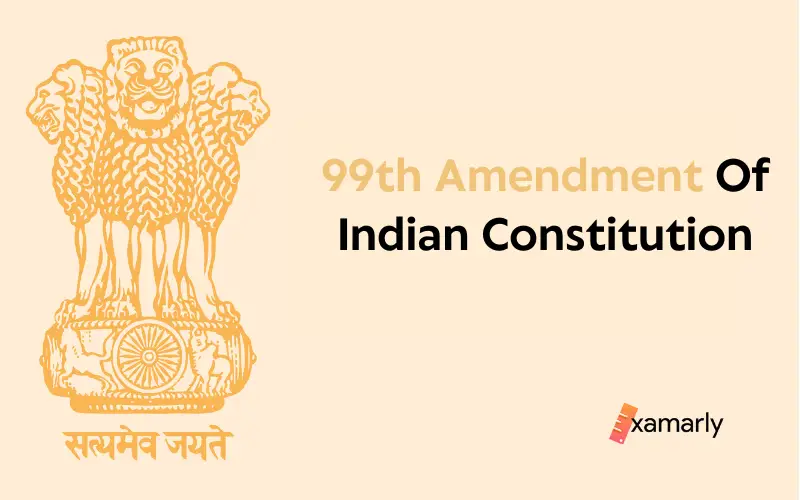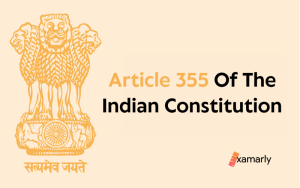A National Judicial Appointments Commission was established by 99th Amendment Of Indian Constitution. The Central Legislation was approved by 16 state assemblies out of 29 states, including Goa, Rajasthan, Tripura, Gujarat, and Telangana. This allowed the President of India to sign the measure into law. On October 16, 2015, the Supreme Court of India rejected the amendment passed by the Government of India.
- Background Of 99th Amendment Of Indian Constitution
- Salient Features And Facts Of The 99th Amendment Of Indian Constitution
- Statement Of Objects And Reasons
- Important Dates Related To The 99th Constitutional Amendment
- Prominent People Involved
- Important Provisions Of The 99th Constitutional Amendment
- The Formulation And Composition Of The Supreme Court
- Structure Of NJAC
- Activities Of The NJAC
- The Ability Of Parliament To Enact Laws
- Appointment Of Ad Hoc Judges
- Participation Of Retired Judges In Supreme Court Proceedings
- High Court Judges' Appointment And Working Conditions Of Their Office
- Transfer Of A Judge From One High Court To Another
- Appointment Of Additional And Acting Judges
- Appointment Of Former Judges To High Court Sessions
- The Creation Of A Shared High Court For Two Or More States
- Selection Criteria For The Chief Justice Of The Supreme Court Of India
- Procedure For Selection Of Further Supreme Court Judges
- The Selection Process For High Court Chief Justices
- Appointment Of Other HC Judges
- President's Authority For Reconsideration
- Judicial Appointments-Related Landmark Decisions
- S.P Gupta v. Union of India (1982)
- Supreme Court Advocates On Record Association v. Union of India (1993)
- The Supreme Court Of India (IN RE: APPOINTMENT & TRANSFER OF JUDGES) v. Civil Advisory Jurisdiction (1998)
- The Reason Behind The Ruling Of The NJAC Unconstitutional
- Supreme Court Advocates-on-record Association v. Union of India (2015)
- Facts Of the case
- Issue of the case
- Supreme Court Bench Observation
- Judgement of the Case
- Ratification
- Summing Up
- FAQ's
Background Of 99th Amendment Of Indian Constitution
- The ” Collegium ” system, which was used in India, permitted only judges to nominate and remove other judges. The phrase “Judges selecting Judges” was another name used for this arrangement. It was invented by the judiciary itself to preserve its independence in selecting judges.
- A new organisation known as the National Judicial Appointments Commission (NJAC) was proposed to take over the role of the collegium of appointment Process for the judges to the Supreme Court and High Courts of the Government of India.
- The NJAC suggested increasing honesty in the Appointment of judges for the High Court, Supreme Court, and Chief Justices respectively. They will be chosen by a commission made up of representatives of the legislative, judicial, and civil society.
- Before NJAC was enacted by the Indian Parliament, the appointment of judges to the superior courts was governed by Articles 124 and 217 of the Indian Constitution. The Chief Justice of India (CJI) and the other judges will be “consulted” before the President of India appoints judges, according to a decision by India’s Supreme Court. According to these provisions, the president, not the prime minister, would designate members of the judiciary.
Salient Features And Facts Of The 99th Amendment Of Indian Constitution
- A proposed organisation called the National Judicial Appointments Commission (NJAC) was tasked with selecting and transferring judges in the various Courts across the nation. To appoint judges, the NJAC stated that the commission will take the place of the earlier collegium system.
- 6 individuals would make up the envisioned mandate.
- It will consist of, The Union Law Minister, the Chief Justice of India (Chairperson), two additional senior Supreme Court judges seated next to the CJI, and two eminent Persons chosen by a committee comprising of the CJI, the Prime Minister, and the Leader of the Opposition.
- The panel has full authority over recommending qualified candidates for each of the following positions: Chief Justice of India, Justices of the Supreme Court, Chief Justices of High Courts, and judges of other High Courts. The Chief Justice of India and transfer of judges of other High Courts will be based on the recommendations of this panel.
- The Supreme Court and 24 high courts’ justices will now be appointed by the Body in charge, National Judicial Appointments Commission (NJAC), which was established by the NJAC Bill 2014, replacing the more than two-decade-old collegium system. The commission’s main office was supposed to be in New Delhi.
Statement Of Objects And Reasons
- According to Article 124, Section 2, and Article 217, Section 1, of the Constitution, respectively, the President appoints the Supreme Court judges and the High Court judges. Ad hoc judges and retired judges for the Supreme Court are chosen by clause (1) of Articles 127 and 128 of the Constitution, respectively.
- The Constitution’s Article 224 governs the nomination of Additional Judges and Acting Judges for the High Court, whereas Article 224-A governs the appointment of retired judges to preside over High Court proceedings. According to paragraph (1) of Article 222 of the Constitution, the President transfers judges from one High Court to another High Court after consulting with the Chief Justice of India.
- The Supreme Court ruled in Supreme Court Advocates-on-Record Assn. v. Union of India (1998) 7 SCC 739, in regards to the definition of “consultation,” had interpreted clause (2) of Article 124 and clause (1) of Article 217 of the Constitution as meaning “concurrence.” A Memorandum of Procedure for Appointing Judges to the Supreme Court and High Courts was created as a result, and it is currently being implemented.
- A broad-based National Judicial Appointments Commission should be established to make recommendations for the appointment of Judges of the Supreme Court and High Courts, it is believed after review of the pertinent constitutional provisions, Supreme Court rulings, and consultations with eminent jurists. The aforementioned Commission would give the judiciary, executive branch, and prominent individuals a significant role to convey their viewpoints and hold participants accountable while also bringing openness to the selection process.
- A National Judicial Appointments Commission will be established thanks to the Constitution (One Hundred and Twenty-first Amendment) Bill, 2014, which is an enabling Constitutional Amendment. The proposed Bill aims to follow Article 124 of the Constitution with new Articles 124-A, 124-B, and 124-C.
- The aforementioned Bill also describes the proposed National Judicial Appointments Commission’s makeup and mandates. Furthermore, it states that Parliament may legislate rules governing judge appointments, and it gives the National Judicial Appointment Commission independence to establish rules governing the way it performs its duties, how Candidates for Appointment are selected, and any other matters that may be deemed important.
- The proposed Bill aims to broaden the criteria used to select judges for the Supreme Court and High Courts, allows the judiciary, administrative branch, and eminent individuals to participate, and provides increased objectivity, transparency, and accountability in the process.
Important Dates Related To The 99th Constitutional Amendment
The 99th Amendment Of Indian constitution of 2014, which was approved by the Lok Sabha on August 13, 2014, amended the Indian Constitution to create the NJAC.
In the Lok Sabha, it was approved with a 2/3 majority. It was approved in the Rajya Sabha the very following day, on August 14, 2014, once more with a two-thirds majority.
On August 14, 2014, the parliament also passed the NJAC Bill 2014 along with the 99th Constitution Amendment Bill 2014.
President Pranab Mukherjee on 31 December 2014, gave his assent to the bill.
The NJAC Act and the Constitutional Amendment Act ultimately took effect on April 13, 2015, after being adopted by 20 of the state legislatures.
Prominent People Involved
The then-Union Minister of law, Ravi Shankar Prasad, Presented the NJAC bill in the Lok Sabha. President Pranab Mukherjee gave his assent to the bill.
Important Provisions Of The 99th Constitutional Amendment
The Formulation And Composition Of The Supreme Court
The formulation and composition of the Supreme Court are covered under Article 124. The Chief Justice of India and up to seven other justices, or more if required by law, make up the Supreme Court of India. the president will have the authority to choose the justice for the Supreme Court using a warrant that bears his signature.
Structure Of NJAC
The NJAC’s composition is outlined in a new Article 124A that was added to the Constitution as part of the Ninety-Ninth Amendment.
- Two of the most senior Supreme Court judges stand next to the Chief Justice of India (Chairperson).
- Justice and Law Minister of the Union
- Two distinguished individuals will be chosen by a committee made up of the Chief Justice of India, the Prime Minister of India, the Leader of Opposition in the Lok Sabha, or the head of the Largest opposition party with the most members in the House ( In the absence of Opposition or Leader of Opposition).
- One of the two eminent persons for the position might be a woman or even a member of a minority group like the SC/ST/OBC. The worthy people are recommended for a term of three years and aren’t entitled to re-nomination.
Activities Of The NJAC
The new article 124B specifies the duties of the NJAC as follows:
- Recommending contenders for positions as the Chief Justice of India, Supreme Court justices, Chief Justices of high courts, and other high court judges.
- Urging the transfer of Chief Justices and other High Court judges from one High Court to another
- Confirming the competence and integrity of the suggested candidates.
The Ability Of Parliament To Enact Laws
Article 124 C specifies the ability of Parliament to enact laws. The Chief Justice of India, along with the other Supreme Court and High Court justices, may be recommended by regulation that is to be managed by the Indian Parliament. The committee may propose any rules and processes necessary for this arrangement.
Appointment Of Ad Hoc Judges
Ad hoc Judges are appointed under Article 127. In Article 127 (1) of the Constitution, the term “the National Judicial Appointments Commission on a recommendation made to it by the Chief Justice of India” shall be used instead of the phrase “the Chief Justice of India.”
Participation Of Retired Judges In Supreme Court Proceedings
The word “the Chief Justice of India” shall be replaced in Article 128 of the Constitution with “the National Judicial Appointments Commission.”
High Court Judges’ Appointment And Working Conditions Of Their Office
The portion of Article 217 (1) of the Constitution that starts with the words “after consultation” and ends with the words “the High Court” shall be replaced with the words, figures, and letter “on the proposal of the National Judicial Appointments Commission” as mentioned in Article 124A.
Transfer Of A Judge From One High Court To Another
Clause (1) of Article 222 of the Constitution shall be modified to read “on the recommendation of the National Judicial Appointments Commission referred to in Article 124A” in place of the wording “after consultation with the Chief Justice of India.”
Appointment Of Additional And Acting Judges
By amending the existing Article 224, the term “the President may, in agreement with the National Judicial Appointments Commission, appoint” will be used in place of the phrases “the President may appoint” in clauses (1) and (2).
Appointment Of Former Judges To High Court Sessions
In Article 224A of the Constitution, the phrase “the Chief Justice of a High Court for any State may at any time, with the previous consent of the President” should be replaced with the phrase “National Judicial Appointment Commission on a reference made to it by the Chief Justice of a High Court for any State, with the previous consent of the President.”
The Creation Of A Shared High Court For Two Or More States
Clause (a) of Article 231’s 2nd clause, which is required under that provision, shall be omitted.
Selection Criteria For The Chief Justice Of The Supreme Court Of India
According to the provisions of the law, the NJAC must nominate the senior-most judge of the Supreme Court for the position of Chief Justice of India. Persons for appointment must be deemed qualified to serve in the position, provided.
Procedure For Selection Of Further Supreme Court Judges
NJAC shall regulate the Selection of Persons for Appointment based on their merit, ability, and other criteria as outlined in the guidelines.
The Selection Process For High Court Chief Justices
The NJAC was given the power to recommend a qualified judge for the office of Chief Justice of a High Court based on their rank among the High Court judges. Additionally taken into consideration are aptitude, merit, and other requirements for appropriateness outlined in the regulations.
Appointment Of Other HC Judges
If a regular High Court Judge is appointed, the commission will also request written comments from:
- Governor of the state
- Chief Minister of the state
- Chief Justice of the High Court
- NJAC members’ right to veto power
The NJAC members can veto the choice of any additional SC and HC judges. If any two of its members do not concur with the NJAC’s recommendation, the NJAC shall not make an appointment recommendation.
President’s Authority For Reconsideration
The act gives the president the authority to reevaluate its recommendations. Following such reconsideration, if the NJAC unanimously recommends making the nomination, the President shall do so.
Judicial Appointments-Related Landmark Decisions
The Indian Constitution was adopted in 1950. According to the Constitution of India, the President was granted power for appointing the rest of the Supreme Court judges before 1973, together with the Chief Justice of India and any Additional justices that he deemed were required for Posting in the Suitable Position. The cases that inspired NJAC’s inception are listed below.
S.P Gupta v. Union of India (1982)
- The aforementioned case of S.P. Gupta v. Union of India (1982) dealt with both the independence of the court and the appointment and removal of judges.
- The validity of Union Government orders that forbade the appointment of two judges was one of the issues that were raised.
- The litigants asked for disclosure of any interaction that the Law Minister, the Chief Justice of Delhi, and the Chief Justice of India may have had to bolster their cause.
Supreme Court Advocates On Record Association v. Union of India (1993)
- A nine-judge Constitution Bench overturned the S P Gupta decision in the case of Supreme Court Advocates on Record Association v. Union of India (1993) by a 7:2 Simple majority and established a special procedure for the appointment and transfer of judges in the higher judiciary known as the “Collegium System.”
- The court ruled that the word “consulting” would not lessen the CJI’s crucial role in appointing judges while still providing the CJI with the upper hand in decisions regarding transfers and appointments.
- This decision curtailed the executive’s control over judge appointments while upholding the fundamental principles of Article 50 of the Constitution. Additionally, the decision disregarded political involvement and personal preferences when making appointments.
The Supreme Court Of India (IN RE: APPOINTMENT & TRANSFER OF JUDGES) v. Civil Advisory Jurisdiction (1998)
- On the President’s recommendation, a body was to be established for the existing collegium system for nominating the judges of the Supreme Court. The Chief Justice of India and the four most senior justices were to make up this panel of a five-judge bench.
- The body of the collegium system for the appointment of High Court justices would consist of the Chief Justice of India and the two senior-most judges;
- A nine-judge Supreme Court bench expressed a unified opinion regarding the collegium system of appointment of judges with the Chief Justice and of four senior judges rather than the two mentioned in the second judge’s case in the third judge’s case of the Supreme Court of India (IN RE: APPOINTMENT & TRANSFER OF JUDGES) v. Civil Advisory Jurisdiction (1998).
The Reason Behind The Ruling Of The NJAC Unconstitutional
Supreme Court Advocates-on-record Association v. Union of India (2015)
The “Fourth Judges Case” is the name given to this famous ruling. It was born out of several petitions that questioned the legality of the NJAC Act and the Ninety-Ninth Amendment.
Facts Of the case
- Litigation involving the NJAC Act and the 99th Constitutional Amendment was to be reviewed by a five-judge Division Bench.
- Articles 124(2) and 217(1) of The Indian Constitution helped in establishing the NJAC and granted it the authority to select, appoint, and transfer judges to the higher courts across the country.
- The Union Minister for Law and Justice, the two Supreme Court justices having the longest terms, the Chief Justice of India, and two eminent persons of society were to hold the key positions in the National Judicial Appointments Commission.
- The Old Collegium system of the judicial process, which the NJAC sought to supersede, included the Chief Justice of India and a panel of the 4 most senior judges of the Supreme Court.
Issue of the case
The bench had to check Whether the 99th Amendment of Indian constitution and the NJAC Act were covered under the provisions of the constitution of India
Supreme Court Bench Observation
- The Supreme Court ruled that the Chief Justice of India and the two senior Supreme Court justices who came after them were inadequately depicting the NJAC’s judicial branch and lacked the necessary numbers of members to uphold the judiciary’s primacy in matters about Appointments of judges and their tenure.
- The idea of “Independence of judiciary” was destroyed by this.
- The Union Minister of Law and Justice breached the separation of Powers as well as the autonomy of the judiciary by taking part in the National Judicial Appointments Commission.
- Sympathy and feelings of malice towards to political executive would be a threat to the integrity of the court.
- The NJAC Act and the 99th Constitutional Amendment were overturned mostly because of the executive’s control.
Judgement of the Case
- The majority, composed of Judges Kehar, Rokur, Goel and Joseph, argued that the involvement of the executive branch in the appointment of judges should be construed in the Basic features of the constitutional framework as to the separation of powers between the supremacy and primacy in terms of the executive and judicial branches. They argued that both principles were violated.
- Even though it is widely accepted that the judiciary’s independence is a fundamental element of the system.
- Justice Chelameswar opposed the other four judges, arguing that granting weight to the judiciary’s viewpoints is not the correct or the sole method for ensuring the efficiency of the judiciary.
- The Chief Justice of India and two senior Supreme Court judges, who constitute the judiciary’s constituents, were unable to maintain the judiciary’s preeminence in terms of nomination and choosing, which jeopardised the integrity of the judiciary.
- A larger bench was also rebuffed, and the cases of the second and third judges were put on hold. should take into account the installation of suitable measures, if any, for better functioning of the collegium system.
- They eventually concluded that the NJAC Act breached important provisions of the Constitution’s protection of judicial independence.
Ratification
The Central Legislation was ratified by 16 state legislative assemblies out of 29 states, which constituted states like Goa, Rajasthan, Tripura, Gujarat, and Telangana. This ratification allowed the President of India to sign the measure into law.
Summing Up
The National Judicial Appointment Commission and the Ninety-Ninth Amendment Act were ruled “unconstitutional and void” by the five-judge Bench of the Supreme Court on October 16 by a 4-1 Special Majority Verdict.
Despite invalidating the NJAC Act, the Supreme Court bench acknowledged the underlying problems with the Ambiguous collegium system and Matters of appointment and requested comments from Indians and Civil Society for ways to make it better. However, the court ought to deal with the long-standing difficulties that had given the call for an NJAC credence. The judiciary should adopt a zero-tolerance policy for corruption and deceit.
Previous Post – 98th Amendment Of Indian Constitution
Up Next – 100th Amendment Of Indian Constitution
FAQ’s
The NJAC bill was introduced in the Parliament of India by whom?
The NJAC bill, 2014, was presented in the Lok Sabha by Mr Ravi Shankar Prasad, the then-Union Law and Justice Minister.
What drawbacks exist in the current Indian Collegium framework?
The collegium system widens the possibilities of favoritism because it provides no guidelines or standards for selecting Supreme Court judges. There are no restrictions in the collegium system for interviewing candidates for appointment or running background checks on them to establish their credibility.
Why was NJAC and the 99th Constitutional Amendment repealed?
The Ninety-Ninth Amendment of the Constitution and the National Judicial Appointment Commission (NJAC) was repealed by the Five-member Constitutional Bench (4:1 Special Majority) of the Supreme Court because they contradict the fundamental principles of the Indian Constitution.
What is the NGAC and the collegium system?
A Constitutional organisation called the National Judicial Appointments Commission (NJAC) was proposed to replace the current Collegium Process of appointing judges.






